In the Lives of the Prophets, a Jewish work from as early as the first century that has been supplemented with Christian additions, we read of the death of Isaiah:
The image captured the imaginations of medieval manuscript decorators:
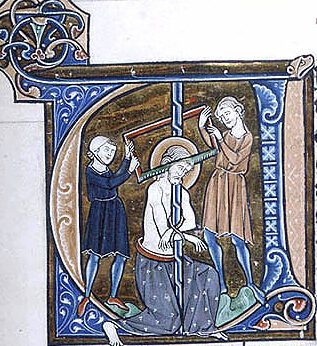
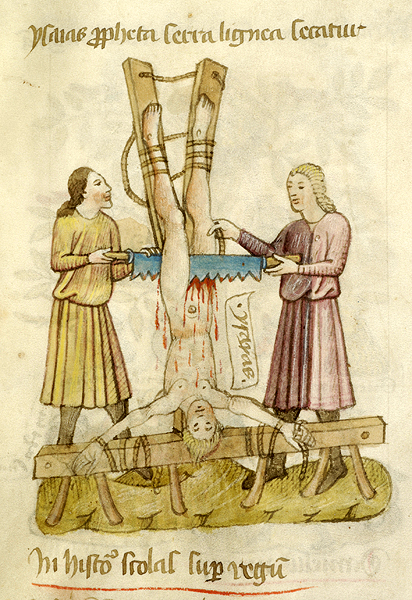
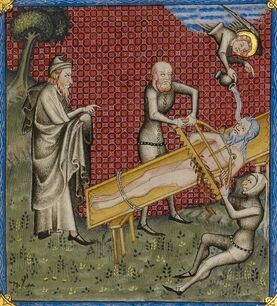

There remains the problem, of which the reader must by now be thoroughly aware, of how a saint and, for that matter, a Jewish prophet, came to be imagined as having died by the extraordinary process of being sawed in two. Even granted that the Middle Ages liked its tales of martyrdom gory and sensational, one cannot help but feel that to saw a man in two is not only cruel, but also unusual and impractical. Other motives besides a preference for the excessive seem required to explain the choice of an instrument of torture which is almost without parallel in the long catalogue of Christian and Jewish suffering. — Bernheimer, 21
Richard Bernheimer’s article was published in 1952 and included the assurance that that “fountain was and still is an intermittent one which flows at irregular intervals.” The reason for the spring’s intermittent performance is attributed to the prayers of the deceased saint buried there. The story of Isaiah’s death has all the appearance of an etiological tale to explain the origin of such a spring.
There is only one explanation for all this: Isaiah, as here presented, is to be taken not as a historical figure, but as the owner of the spring, its lord and tutelary demon; the story about his miraculous activities is an etiological legend meant to explain the origin of the spring, its name and its puzzling intermittence; and the connection of Isaiah with it is a mere abuse of his name, encouraged by the chance circumstance that he had mentioned Siloam in several of his prophecies.
There was a Baal Perazim (“owner of the outflow”) and Baal Hamon (“owner of the torrent”), each suggestive of a demon and a water locality.
Yet Isaiah’s martyrdom itself is directly linked to the explanation of the occasional performance of the spring. Isaiah prayed for just a little water whilst his executioners were sawing away at his body and that prayer was answered by means of the spring. The reason the Jews were said to have buried the two halves of his body beside the spring was so that the effect of his prayers could continue to provide (intermittent) water for the locals. So it was Isaiah’s death that continued to benefit future generations. The conclusion that follows is grim:
The pious legend reveals itself as a rather thinly disguised account of a sacrificial act, imagined or performed as a regular contribution to fertility or as a means of propitiating the capricious and unreliable lord of the spring in times of drought. If it is a propitiatory act — and we have no means of ascertaining, whether the story is not rather mythological — then the ritual must have taken the form, all too familiar in ancient Palestine, of a human sacrifice. . . .
. . . but “sawing as a method of human sacrifice was not among the usual procedures of the cult practised in ancient Palestine. (27f)
Is there evidence of sacrifice by this method?
To this writer’s knowledge, only one historical case of this kind of human torture must be acknowledged beyond dispute. A moderate distance from Jerusalem, at Gezer, excavations conducted a few decades ago yielded, together with other evidence of ritual cruelties, the well-preserved upper parts of two human bodies, which apparently had been sawed in two when still alive — one belonging to a youth of about eighteen years, the other to a girl one or two years younger. While the purpose of these slayings, dating back to the second millennium B.C., is not known, it is perhaps not pointless to observe that Gezer had a water system similar to that in Jerusalem, and that the killing may have been done for its benefit.
There is, furthermore, the somewhat doubtful passage in the book of Samuel which asserts that David submitted the inhabitants of conquered Rabat Amon to iron saws and flails and burned them in brick kilns — atrocities of which recent commentators have tried to absolve him by translating that he set them to work at the instruments in question. The older version, if correct, implies that the penalties meted out to the defeated garrison were continuations into the political field of practices originally connected with human sacrifice. (28)
This brings us to ancient mythology. There survives an Egyptian tale of two brothers in which a shepherd goes to the Valley of Cedars in Lebanon and deposits his heart on the top of one of the trees. When the tree is felled he himself falls dead. Another ancient tale has the coffin of Osiris drifting to Lebanon where a tree grows around it. A king thought it the largest and finest tree so had it cut down to be used as a column in his palace.
We are here dealing with a Phoenician cedar god who dies as his tree is cut in two. (28)
One has to wonder if there is some belief in the magic of a body being cut like a tree gives life to the ground as a result of the victim becoming analogically part of the vegetation.
Bernheimer adds (writing, as we said, in 1952)
It is amusing to record in this connection that the present Mohammedan population of Jerusalem, oblivious of the ancient tradition attached to it, explains the periodicity of the Gihon by saying that the spring used to be inhabited by an evil spirit in the form of a camel which stopped its flow by drinking up the water. That camel, we are told, is now dead, and has been replaced by chickens! (31)
But why was Isaiah so connected in order to “historicize” such a pagan tradition and custom? In Isaiah 22:9-11 and 8:6-8 we read of that prophet’s connection with the pool of Siloam.
You saw that the walls of the City of David
were broken through in many places;
you stored up water
in the Lower Pool.
10 You counted the buildings in Jerusalem
and tore down houses to strengthen the wall.
11 You built a reservoir between the two walls
for the water of the Old Pool,
but you did not look to the One who made it,
or have regard for the One who planned it long ago.
and
“Because this people has rejected
the gently flowing waters of Shiloah [=Siloam]
and rejoices over Rezin
and the son of Remaliah,
7 therefore the Lord is about to bring against them
the mighty floodwaters of the Euphrates—
the king of Assyria with all his pomp.
It will overflow all its channels,
run over all its banks
8 and sweep on into Judah, swirling over it,
passing through it and reaching up to the neck.
Its outspread wings will cover the breadth of your land,
Immanuel!”
Bernheimer, Richard. “The Martyrdom of Isaiah.” The Art Bulletin 34, no. 1 (1952): 19–34. https://doi.org/10.2307/3047388.
If you enjoyed this post, please consider donating to Vridar. Thanks!

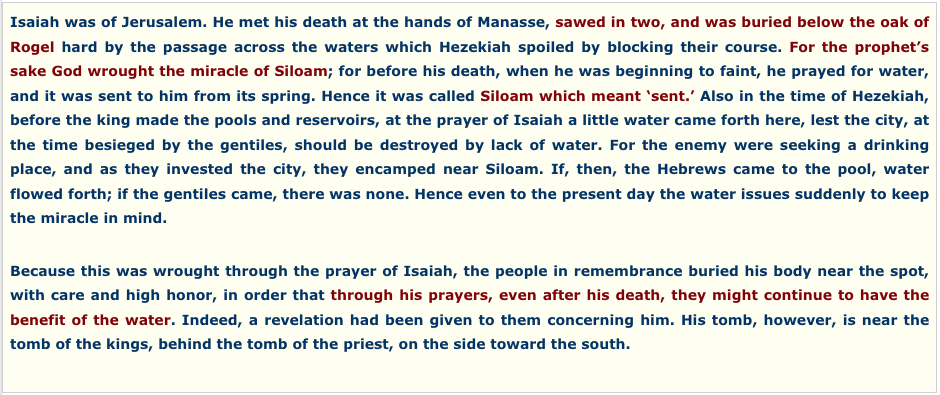
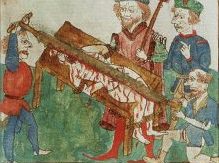
This always struck me as an association with the dying-and-rising gods who are typically portrayed as being born or killed under or within a tree. The story blames Manasseh, but it was Hezekiah who was known to have torn down all the tree-like Asherah poles, probably to force the Judeans to sacrifice at the Jerusalem Temple instead so as to better collect money for the oncoming Assyrian aggression. If Isaiah had any associations with those shrines, then it would make sense that he would prophecize Hezekiah’s death at the hands of Sennacherib. The priests writing 2 Kings obviously wanted to sanitize Isaiah for the same reason Republicans call Martin Luther King Jr. a Conservative and so they invented a story in which Isaiah only prophecized Hezekiah’s death because Hezekiah happened to be sick and on his deathbed at the time and in fact only minutes later Isaiah came back and told him that “Yahweh had seen his tears” and changed his mind. Hezekiah’s’ propagandists took the fact that Jerusalem held the siege as proof of victory but the war devestated the country and no doubt caused a lot of resentment among the Judean commoners. Originally, Isaiah was probably fondly remembered for going up against the Judean royal class before his story was revised by “Yahweh Only” party.
Your comment reminds me of another portion of Bernheimer’s article that I did not include in the post:
Irony upon irony.
Re: “as an association with the dying-and-rising gods who are typically portrayed as being born or killed under or within a tree.”
Often a terebinth: https://www.haaretz.com/archaeology/2014-12-03/ty-article/.premium/the-god-factor-and-the-pistachio/0000017f-e2ac-d9aa-afff-fbfc8c830000 I was recently thinking in the back of my mind about those dying-and-rising gods from the Ugaritic Baal Cycle while comparing what Van Der Toorn wrote on deities of Elephantine [Anat-Yahu and others] in a 1992 article: https://usa1lib.org/book/862680/45e7c4 with what he wrote in a 2019 book: https://usa1lib.org/book/16453335/e6a079
https://en.wikipedia.org/wiki/Anat#In_Phoenician_and_Cyprian_inscriptions,_Athene Anat = Athena = Neith Parallelomania continues but how to solve the problem of those Asherah pole vis a vis Anat-Yahu
Neil : Richard Bernheimer was an interesting and suggestive scholar, but in this instance the attraction of tracing alleged folkloric survivals over the centuries seems to have led you to park your usual methodological rigour regarding attestation, context, etc.
More to your taste would be David Satran’s concise (120 pages) monograph, ‘Biblical Prophets in Byzantine Palestine : Reassessing the Lives of the Prophets’ (1995).
Satran in effect uses the ‘Lives’ as a test case against the common assumption that we only have to remove a few areas of Christian over-painting on a text to reveal a pristine Jewish work, which is then (inevitably !) dated to the first century.
He argues that the ‘Lives’ is at all levels a profoundly Christian work, in all of its many versions; that the focus on miracle-working holy men, their role as intercessors, and the sacred topography of their tombs, is a very C4/C5 Christian one. He does not see an ur-text as recoverable; even if it was, it would not necessarily be Jewish, let alone C1.
So the picturesque death of Isaiah may be a folk-tale from way back, to which Heb.11.37 refers, but the ‘Lives’ are not evidence for that. It is possible but we do not know. What we do know is that this tale is only known in its earliest examples (Dialogue with Trypho 120, Ascension of Isaiah 5 [if ‘early’]) from comparatively ‘late’ Christian texts.
I think I’m on the same page as you. I limited my reference to Lives of the Prophets here but could have added the Ascension of Isaiah and Talmudic references. The evidence, such as it is, for a spirit of the spring and possibly human sacrifice, are drawn from sources external to the Lives. As you note, the possibility for a folk-tale is from “way back”. I thought Bernheimer’s discussion of interest, nothing more. I was alerted to it by Norelli when he said in another discussion of his on the Ascension of Isaiah that few if any AscIsa scholars had read it.
“the well-preserved upper parts of two human bodies, which apparently had been sawed in two when still alive — one belonging to a youth of about eighteen years, the other to a girl one or two years younger…
Gezer had a water system similar to that in Jerusalem, and that the killing may have been done for its benefit.
I think that’s a real stretch. Common sense would say an 18 year old boy and 16 girl dispatched in such a manner (together) would more likely be done for some sexual misconduct in ancient times. Not for a water system’s benefit.
Executing the couple is one thing, but you don’t think something else would normally be needed to explain why each was cut in two, in half?
Not knowing the details of the archeology find, and just going by the comments, “the well-preserved upper parts”…the obvious question is why no bottom parts? That seems very strange. Certainly bottom parts have more to do with sex than water sources. But I don’t think it’s worth too much thought. Random finds with no direct evidence of cause can be explained in a million ways, probably. Without more evidence, who knows?
The stories of Isaiah are infamous for being mostly, possibly, very late; even tailored for Christian parallels. Maybe stories of Isaiah being torn in half, are about redaction, subtractive exiting? Separating older from newer material?
Not so late in this case. I know that the Ascension of Isaiah is dated by some leading experts on that text to the late first or early second centuries and there the fate of Isaiah is described in a Christian text. When we read of Isaiah’s fate in later rabbinical literature, it is reasonable to accept that those Jewish writers did not borrow the story from Christians but were drawing upon their own traditions. It follows, then, that the Ascension of Isaiah was likewise drawing upon those same Jewish traditions. So the account of Isaiah being sawn in two very probably goes back to the first century at the latest.
(Some have thought that the matyrdom of Isaiah in the Ascension of Isaiah originated as a Jewish text that was expanded by Christian additions but other research that I may post about some time indicates that the whole of the Asc of Isa, including the story of his martyrdom, was Christian from the start. But the Christian author was building on a Jewish belief that Isaiah had been sawn in two.)
“a Jewish prophet, came to be imagined as having died by the extraordinary process of being sawed in two. Even granted that the Middle Ages liked its tales of martyrdom gory and sensational, one cannot help but feel that to saw a man in two is not only cruel, but also unusual and impractical. Other motives besides a preference for the excessive seem required to explain the choice of an instrument of torture which is almost without parallel in the long catalogue of Christian and Jewish suffering.”
Not particularly unusual I think. 2 Macc 14:37-46 (probably 2nd century BC), “37 A certain Razis, one of the elders of Jerusalem, was denounced to Nicanor as a man who loved his compatriots and was very well thought of and for his goodwill was called father of the Jews….46 with his blood now completely drained from him, he tore out his entrails, took them in both hands, and hurled them at the crowd, calling upon the Lord of life and spirit to give them back to him again. This was the manner of his death.”
All Jewish, BC. No Christian in site.
How about Both And, rather than Either/Or? Torture existed in all ages. Christians then made partly pre-existing tortures a key element, as part of a program to emphasize martyrdom.
There I also like the links to pagan fable tortures or splits too. Protestants always said Catholic saints expropriated old pagan heroes.
Dates? Yet to be fully determined, as always.
The links are.interesting. And the splits – and splitoffs – are interesting too.
Neil is right; the writing attributed to or about Isaiah, include at least two parts: 1) older writings and sayings possibly from the 8th cent. BCE, then 2) later writings. Possibly 1st to 3rd cent. ACE?
But whatever the dates, we have in effect an Isaiah divided into at least two major parts; one probably older, another relatively newer.
Original and interpolation?
Maybe newer writers also then went back into earlier history – Midrash style – to try to justify the two-parted Isaiah they had created by their redactions, interpolations. Picking up say, among other things, old myths of various two-parted, divided heroes, martyrs.
I put nothing past sly redactors, editors, interpolationists
From Josephus, Jewish War, 5.9.4:
And as for Titus, those springs that were formerly almost dried up, when they were under your power; since he is come, run more plentifully than they did before.
Accordingly, you know that Siloam, as well as all the other springs that were without the city, did so far fail; that water was sold by distinct measures:36 whereas they now have such a great quantity of water for your enemies, as is sufficient not only for drink, both for themselves, and their cattle; but for watering their gardens also. The same wonderful sign you had also experience of formerly; when the forementioned King of Babylon made war against us; and when he took the city, and burnt the temple. While yet I believe the Jews of that age were not so impious as you are.
Wherefore I cannot but suppose that God is fled out of his sanctuary, and stands on the side of those against whom you fight.
Josephus appears to have known the Isaiah legend, and reworked it to show god had abandoned the rebellious Judeans in favor of the Romans.
One of the oldest, most fundamental, primal, peculiarly Roman gods, was the two-faced Janus. He was said to be the god of changes, passages, transitions; associated appropriately with doorways. Where the bifurcated faces, facing different directions, indicate you could go in – or out.
Because this figure allowed passages in opposite directions, and had two faces, in our modern era it became synonymous with hypocrisy and being “two-faced”.
Here it sounds like the transitioning, bifucating Jewish/Roman collaborator Josephus, might have been thinking about all that. And reversing, splitting off the alleged flow of Godly benefits. From God to the Jews and Jerusalem, to the Romans and gentiles. A concept very heavily foregrounded by the apostle Paul, and the “new covenant”. Or replacement theology.
There is a bust of a bifurcated Janus in the Vatican museum.
Any thoughts about how the two-faced Josephus never directly says who exactly his father was and what role in wider events he [the father] may have played?
Feel free to elaborate.
Briefly of course, in general, the question of who our “father” is, is partly about our legitimacy. And loyalty to what traditions.
People asked Jesus who is father was; he responds vaguely, quite like Josephus ? A vague father in heaven is mentioned. One Jewish tradition said Jesus waa literally a memzer; a half breed from a Jewish mother and Roman soldier, Pantera. In any case, it’s a useful fugure; many see Christianity as parts of Judaism, collaborating with Greco Roman rulers, traditions.
Possibly the newer, rather Christian parts of Isaiah were written by such collaborationists in Israel, or even Rome. Where Peter and Paul were said to have ended up. Fathers of the Roman Church.
Josephus seems to be a very key, early figure in all this. Almost a c. 70 AD prototype for any (later?) versions of Jesus. Or a rough late contemporary.
Josephus consistently degrades the rebels as reckless criminals in his histories. Thus it is strange to find Josephus appointed the rebel commander for the northern part of the Jewish kingdom. The situation reminds one of a famous quote from Vladimir Lenin, “The best way to control the opposition is to lead it ourselves.” Josephus and the chief priests in Jerusalem were skilled political strategists clearly ahead of their time.
One is left to wonder whether General Josephus ben Matthias fought and commanded his troops to the fullest extent of his abilities while defending Galilee against the Romans, a war he counseled against and opposing an enemy he later joined. Had Josephus given his allegiance to the Romans even before his capture at Jotapata? The only evidence we have comes from the writings of Josephus himself.
The relation between Matthias the father of Josephus and high priest Matthias ben Theophilus strikes one as a Clark Kent / Superman situation. Has anyone ever seen them together in the same room? Josephus proclaims he was from a family of high priests. Further as a young man he was given important assignments by the chief priests in Jerusalem. It appears that his brother was also made a rebel commander. These facts indicate that the father of Josephus was a very important figure in Jerusalem, certainly a chief priest and perhaps a high priest. When telling the story of the great Jewish revolt in ‘Antiquities’, Josephus mentions high priest Matthias ben Theophilus but not his father. When telling the story of the great Jewish revolt in ‘Jewish Wars’, Josephus mentions his father but not high priest Matthias ben Theophilus. The high priest MbT was mentioned in ‘Antiquities’ but disappeared from ‘Jewish Wars’ because he was referred to in that work as “the father of Josephus”. Could it be they were one in the same person?
There is no doubt that Josephus had at least two opposite, split and then clumsily-rejoined personalities: loyal traditional Jew, vs. Roman collaborator. Who knows how many others. Josephus liked playing both sides.
Likewise, many scholars feel the book of Isaiah includes a second (and third?), interpolated side, that seems partly designed to make Judaism appear more compatible with other cultures, like Christianity. A Christlike savior.
Playing around with his origin, his provenance, offering, hinting at many different possibilities, was possibly one of Josephus’s ways of playing every side.
I don’t think Josephus was a general over rebels. I think it was more complicated than that. The zealots and seditious started the war, and the rest just got sucked into it without a choice. Most of the upper class wanted to live with the Romans, and not get the city and temple destroyed. Zealots ended up killing Roman solders.
“2.17.2
2. And at this time it was that some of those that principally excited the people to go to war made an assault upon a certain fortress called Masada. They took it by treachery, and slew the Romans that were there, and put others of their own party to keep it. At the same time Eleazar, the son of Ananias the high priest, a very bold youth, who was at that time governor of the temple, persuaded those that officiated in the Divine service to receive no gift or sacrifice for any foreigner. And this was the true beginning of our war with the Romans; for they rejected the sacrifice of Caesar on this account; and when many of the high priests and principal men besought them not to omit the sacrifice, which it was customary for them to offer for their princes, they would not be prevailed upon. These relied much upon their multitude, for the most flourishing part of the innovators assisted them; but they had the chief regard to Eleazar, the governor of the temple.
3. Hereupon the men of power got together, and conferred with the high priests, as did also the principal of the Pharisees; and thinking all was at stake, and that their calamities were becoming incurable, took counsel what was to be done. Accordingly, they determined to try what they could do with the seditious by words,“